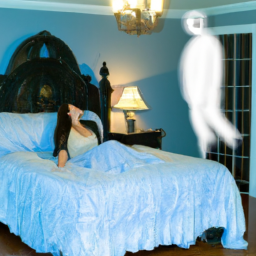Lucid Dreaming Techniques
Why Do Some Dreams Seem So Real

Have you ever awakened from a dream feeling confused and disoriented? Perhaps you felt as though you were truly in the dream, experiencing it firsthand.
I remember one dream where I was being chased by a monster, and I could feel my heart pounding and my breath quickening as if it was all really happening. It’s a strange sensation, to be sure, but it’s not uncommon.
So why do some dreams seem so real?
Well, there are a few different factors at play here. For starters, our brains are incredibly complex, and the processes that take place during sleep are still not fully understood.
Additionally, the content of our dreams is influenced by a variety of internal and external factors, such as our subconscious thoughts and emotions, our daily experiences, and even the foods we eat.
In this article, we’ll explore some of the science and psychology behind why some dreams feel so vivid and lifelike.
Key Takeaways
- Different stages of sleep, especially REM sleep, can lead to highly active brain and paralyzed body, creating a different state of consciousness during sleep which contributes to the mysterious and fascinating experience of dreaming that feels inexplicably real.
- Dreams tap into deepest fears, desires, and experiences, and create a reflection of daily experiences in the subconscious mind, which is responsible for processing thoughts, emotions, and memories. External factors, such as sleep disorders, psychological factors like stress and anxiety, and cultural interpretations, can greatly impact dream vividness and emotional intensity.
- Memory consolidation occurs during sleep, and the amygdala is responsible for processing emotions during dreaming while the frontal cortex is involved in decision-making and problem-solving but with reduced activity. Understanding the impact of external factors can create a more conducive sleeping environment, and without enough sleep, the brain struggles to consolidate memories, leading to forgetfulness and difficulty retaining new information.
- Lucid dreaming is a state where one is aware of dreaming and can control actions and surroundings, allowing exploration of the subconscious. Various techniques can be used to achieve lucid dreaming, such as keeping a dream journal and reality testing by asking if dreaming throughout the day.
The Basics of Dreaming
Dreaming is a mysterious and fascinating experience that often feels inexplicably real. During sleep, our brains enter a state of consciousness that is different from our waking state. Our brains are still active during this state, but they’re processing information in a different way.
While we sleep, our brains go through different stages of sleep, including REM (Rapid Eye Movement) sleep. During REM sleep, our brains are highly active and our bodies are essentially paralyzed. It’s during this stage that we typically experience the most vivid and memorable dreams.
So, why do some dreams seem so real? It may have to do with the way our brains process information during this unique state of consciousness.
Next, we’ll delve into the role of the subconscious mind in dreaming and how it may contribute to the realism of our dreams.
The Role of the Subconscious Mind
When we’re asleep, our subconscious mind takes over and creates a vivid experience that feels just as real as the waking world. This is because the subconscious mind is responsible for processing thoughts, emotions, and memories that we may not be consciously aware of.
During sleep, the subconscious mind becomes more active and can create dreams that tap into our deepest fears, desires, and experiences. The subconscious mind is also responsible for storing and processing memories, which is why dreams can often be a reflection of our daily experiences.
However, not all dreams are a direct representation of our waking life. Sometimes, the subconscious mind can create entirely new scenarios and experiences that we may not have experienced before. Understanding the role of the subconscious mind in dreaming is an important step towards unlocking the mysteries of our nighttime experiences and the science of memory consolidation.
The Science of Memory Consolidation
As I lay in bed at night, my brain is hard at work, replaying and consolidating the memories of my day like a movie projector on repeat. This process, known as memory consolidation, is a crucial aspect of our brain’s function. It helps us process and remember important information, while discarding unnecessary details.
During this process, the brain takes the memories from short-term storage and transfers them to long-term storage, making them more permanent. Memory consolidation occurs during sleep, when our brains are in a state of rest and relaxation.
This is why it’s crucial to get enough sleep each night, as it allows our brains to properly process and store memories. Without enough sleep, our brains may struggle to consolidate memories, leading to forgetfulness and difficulty retaining new information. So, while it may seem like we’re just lying in bed doing nothing, our brains are actually hard at work consolidating memories and preparing for the next day.
The Brain’s Processing During Sleep
So, I’m fascinated to learn about the brain’s processing during sleep.
Two key areas of interest are the amygdala and frontal cortex.
The amygdala is responsible for processing emotions and is active during dreaming, which may explain why some dreams feel so real.
The frontal cortex, on the other hand, is involved in decision-making and problem-solving, but its activity is reduced during dreaming, which may explain why our dreams can be illogical and bizarre.
The Role of the Amygdala in Dreaming
The amygdala plays a crucial role in making dreams feel intensely vivid and realistic. Here are four ways that the amygdala affects the dreaming experience:
-
Emotion regulation: The amygdala is responsible for regulating emotions, and this function spills over into our dreams. This is why we often wake up feeling strong emotions like fear, anxiety, or happiness after dreaming.
-
Memory consolidation: The amygdala is also involved in consolidating memories during sleep. This means that the emotional content of our dreams can help us store and recall memories better.
-
Visual processing: The amygdala receives visual information from the eyes and processes it to create vivid mental images. This is why dreams often feel like watching a movie or experiencing a realistic simulation.
-
Fight or flight response: The amygdala is responsible for triggering the fight or flight response in dangerous situations. During a nightmare, the amygdala may interpret the dream as a threat and activate this response, causing physical sensations like sweating or increased heart rate.
As important as the amygdala is for dreaming, it’s not the only brain region involved. The function of the frontal cortex in dreaming is also worth exploring.
The Function of the Frontal Cortex in Dreaming
Our brains’ frontal cortex plays a crucial role in shaping the content of our dreams. This region of the brain is responsible for many higher-order cognitive functions, such as decision-making, planning, and working memory. During REM sleep, the frontal cortex becomes less active, allowing for more random and associative thoughts to arise. However, even though the frontal cortex is less active, it still plays an important role in the content of our dreams.
Research has shown that the frontal cortex is responsible for things such as setting the scene, creating characters, and controlling the plot of our dreams. This means that the events and people we encounter in our dreams can be influenced by our memories, desires, fears, and emotions. Additionally, the frontal cortex is also responsible for creating a sense of self in our dreams, allowing us to experience them as if we are actually there. So, while our dreams may seem incredibly vivid and real, they are actually the result of our brain’s complex processes.
As we’ve seen, the frontal cortex plays a significant role in shaping the content of our dreams. However, other factors can also influence our dreams, such as external stimuli or events in our lives. In the next section, we’ll explore how these external factors can impact the content of our dreams.
The Influence of External Factors
You might wake up feeling like you’ve just experienced a vivid dream because external factors can affect the intensity of your dreams. For example, if you’re sleeping in a room that’s too hot or too cold, your body may be uncomfortable and restless, causing your dreams to feel more intense and vivid.
Similarly, if there’s a lot of noise coming from outside your window or within your house, your brain may incorporate those sounds into your dream, making it feel more realistic.
In addition, the amount of light in your sleeping environment can also affect your dreams. If you’re sleeping in complete darkness, your brain may create more visual imagery in your dreams to compensate for the lack of external stimuli. On the other hand, if there’s a lot of light in your room, your dreams may be less vivid because your brain is receiving more visual information from the environment.
Understanding the impact of external factors on dream intensity can help you create a more comfortable and conducive sleeping environment, which may lead to more restful sleep and more enjoyable dreams. As a result, you may even be able to harness the power of your dreams for lucid dreaming.
Lucid Dreaming
I’m excited to talk about lucid dreaming! For those who are unfamiliar, lucid dreaming is when you become aware that you’re dreaming while you’re still within the dream.
This realization can allow you to take control of the dream and even manipulate its contents. There are various techniques you can use to achieve lucid dreaming, and we’ll explore some of the most effective ones.
Definition and Explanation
If you’ve ever had a dream that felt like reality, it’s likely because your brain is unable to distinguish between the two states.
Lucid dreaming is a state where you are aware that you are dreaming, and you can control your actions and surroundings. It’s a fascinating phenomenon that allows us to explore our subconscious mind and experience things that we wouldn’t be able to in the waking world.
During a lucid dream, you can fly, teleport, and even talk to your subconscious mind. The experience of lucid dreaming varies from person to person, and some people are able to achieve it naturally, while others need to practice certain techniques.
However, the benefits of lucid dreaming are numerous, and it’s a skill that anyone can learn. By mastering the techniques for achieving lucid dreaming, you can unlock your mind’s potential and have incredible experiences that you never thought were possible.
Techniques for Achieving Lucid Dreaming
As I mentioned earlier, lucid dreaming is when you become aware that you’re dreaming and can control the content of the dream. It’s a fascinating experience that many people would like to achieve. So, how can you achieve lucid dreaming? There are several techniques you can try.
One technique is reality testing, where you ask yourself if you’re dreaming throughout the day. If you do this habitually, you may start to do it in your dreams and realize that you’re, in fact, dreaming.
Another technique is keeping a dream journal and writing down your dreams every morning. This helps you become more aware of your dreams and may help you recognize when you’re dreaming.
There are also various meditation and visualization exercises you can do to prepare your mind for lucid dreaming. With practice, anyone can achieve lucid dreaming and experience the wonder of controlling their dreams.
Now, while lucid dreaming is a fascinating experience, it’s important to note that some sleep disorders can negatively impact your dreams. Let’s explore some of these disorders and how they affect our sleep and dreams.
Sleep Disorders
You may experience vivid and lifelike dreams if you suffer from certain sleep disorders. These disorders can disrupt your sleep cycles, leading to intense and unforgettable dreams.
Here are three sleep disorders that may cause you to have exceptionally realistic dreams:
- Rapid Eye Movement (REM) Sleep Behavior Disorder: This disorder causes people to physically act out their dreams while sleeping, which can lead to intense and vivid experiences.
- Sleep Apnea: People with sleep apnea often experience fragmented sleep, which can lead to more vivid dreams. Additionally, the low oxygen levels caused by sleep apnea may lead to hallucinations and intense dream experiences.
- Narcolepsy: This neurological disorder can cause people to fall asleep suddenly and unexpectedly, often leading to vivid and intense dreams during the rapid onset of REM sleep.
Sleep disorders are just one factor that can contribute to the realism of our dreams. Next, we’ll explore how psychological factors can also influence our dream experiences.
Psychological Factors
Psychological factors, such as stress and anxiety, can greatly impact the vividness and emotional intensity of our dreams – studies have shown that up to 70% of people who experience high levels of stress report having more vivid and disturbing dreams. When we are under stress, our minds are working through unresolved issues and worries, and these thoughts can manifest themselves in our dreams. Additionally, anxiety can also cause our brains to be hyperactive during sleep, leading to more intense dreams.
To further understand the relationship between psychological factors and dream vividness, I created a table to outline some common sources of stress and their potential effects on dreams:
| Source of Stress | Potential Effects on Dreams |
|---|---|
| Work-related stress | Dreams about being unprepared or failing at work tasks |
| Relationship stress | Dreams about conflict or betrayal |
| Financial stress | Dreams about loss or failure |
| Health-related stress | Dreams about illness or death |
It is important to note that not all dreams are negative or disturbing – some people report having more positive or creative dreams when they are feeling relaxed and content. However, understanding the impact of psychological factors can help us better interpret and cope with our dreams.
Moving forward, exploring cultural and spiritual interpretations of dreams can provide further insight into the significance and meaning of our dream experiences.
Cultural and Spiritual Interpretations
Exploring cultural and spiritual interpretations of dreams can uncover a deeper significance and meaning behind our nighttime visions.
In some cultures, dreams are believed to be messages from the divine or ancestors. For example, in some Native American cultures, dreams are seen as a way for ancestors to communicate important messages or warnings. Similarly, in ancient Egyptian culture, dreams were believed to be prophetic and were often interpreted by priests to guide the pharaohs.
In addition to cultural interpretations, many spiritual practices also emphasize the importance of dreams. For example, some religions believe that dreams can provide insight into one’s spiritual journey and can even bring one closer to the divine. In Buddhism, for instance, dreams are seen as manifestations of one’s karma and can be used as a way to cultivate mindfulness and awareness.
Overall, exploring cultural and spiritual interpretations of dreams can provide a unique perspective on the significance of our nighttime visions and can offer valuable insights into our personal growth and development.
Frequently Asked Questions
How does dreaming differ between different age groups?
As we age, our dream patterns change. Children have more frequent nightmares, while adults have longer, more complex dreams. Older adults tend to have less vivid dreams. However, the intensity of a dream can vary greatly from person to person regardless of age.
Can certain foods or medications affect the vividness of dreams?
Certain foods and medications can affect the vividness of my dreams. For example, eating spicy food or taking antidepressants can make my dreams more intense. However, I don’t think they necessarily make them feel more "real."
Is there a connection between dream content and a person’s personality traits?
I believe there is a connection between my dream content and my personality traits. I often dream about my fears, desires, and unresolved issues. These dreams reflect my subconscious mind and help me understand myself better.
Can recurring dreams be a sign of a deeper psychological issue?
Recurring dreams of being chased haunted me for months. My therapist uncovered that it was a manifestation of anxiety and a fear of failure. Once we addressed the root cause, the dreams stopped.
Are dreams affected by the time of day or duration of sleep?
I’ve noticed that my dreams vary based on the time of day and how long I sleep. Longer periods of sleep result in more vivid dreams, while napping during the day often leads to more fragmented and disjointed dreams.
Conclusion
So, why do some dreams seem so real? There are a multitude of factors that contribute to the vividness and intensity of our dream experiences. Our brains are constantly processing and consolidating information during sleep, which can sometimes result in incredibly lifelike dream scenarios.
Despite our scientific understanding of the mechanisms behind dreaming, there is still so much we don’t know about this mysterious realm of the mind. Perhaps it’s this sense of wonder and intrigue that keeps us coming back to our dreams, even when they leave us feeling confused, scared, or exhilarated.
So the next time you wake up from a particularly vivid dream, take a moment to reflect on the incredible power of your own mind and the endless possibilities that lie within it. Who knows what incredible adventures await you in your next dream?
Eislyn is a gifted writer whose words weave enchanting narratives within the realm of dreams. With a profound love for storytelling and a deep curiosity about dreams, Eislyn’s articles transport readers into vivid dreamscapes.
Her writing style is both eloquent and thought-provoking, captivating readers’ imaginations and inspiring them to dive deeper into the mysteries of their own dreams. Eislyn’s exploration of dream symbolism and interpretation adds depth and nuance to our content, making it an absolute pleasure for dream enthusiasts to engage with.
Lucid Dreaming Techniques
Dreams About Vampires What Do They Mean

I have always been fascinated by the world of vampires. From the infamous Count Dracula to the sparkling vampires of Twilight, these mythical creatures exude a mysterious and captivating allure. So it was only natural that I found myself curious about the significance of my dreams involving vampires.
Dreams about vampires are not uncommon. They can be both terrifying and exhilarating, leaving you with a sense of unease or excitement when you wake up. However, these dreams are not just random occurrences. They often hold deep meanings and can provide insight into your subconscious mind.
In this article, I’ll explore the symbolism of vampires in dreams, the different types of dreams you may have, and how to interpret them.
Key Takeaways
- Dreams about vampires can reveal deep meanings and insights into the subconscious mind.
- Vampires in dreams symbolize eternal life, youthfulness, power, control, and a fear of death.
- Personalizing the dream and analyzing emotions and triggers can help interpret the hidden meanings and messages in the dream.
- Seeking professional help from a licensed therapist can provide deeper understanding and tools to manage dreams about vampires.
Overview of Dreams About Vampires
If you’ve ever had a dream about vampires, you know how creepy and unsettling they can be. As someone who’s had their fair share of dreams about these bloodthirsty creatures, I can attest to the fact that they can be downright terrifying.
It’s not just the sharp fangs or the pale skin that makes them scary, but also the fact that they represent something much deeper.
Dreams about vampires are often associated with fear and anxiety. They’re symbolic of the things that scare us the most in our waking lives, whether it’s a fear of death, a fear of the unknown, or a fear of losing control.
That being said, there’s much more to these dreams than just fear. Vampires also hold a great deal of symbolism, which we’ll explore in the next section.
Symbolism of Vampires in Dreams
You might be surprised to learn that when you dream of blood-sucking creatures, they could represent something else entirely. Can you think of any other creatures that might symbolize youth and immortality? Vampires are often seen as symbols of eternal life and youthfulness, as they are able to live forever and never age. In dreams, vampires can represent a desire for immortality or a fear of aging and death. They can also represent a sense of power and control, as vampires are often depicted as having superhuman strength and the ability to control others.
To further illustrate the symbolism of vampires in dreams, consider the following table:
| Symbol | Interpretation | Example |
|---|---|---|
| Fangs | Fear or aggression | Feeling threatened or attacked |
| Pale skin | Illness or death | Fear of illness or mortality |
| Blood | Vitality or life force | Desire for energy or passion |
| Immortality | Eternal youth or power | Desire for longevity or control |
Understanding the symbolism of vampires in dreams can help you interpret the meaning behind your dreams. However, keep in mind that the interpretation of dreams is subjective and unique to each individual. In the next section, we will explore different types of dreams about vampires.
Different Types of Dreams About Vampires
Get ready to explore the different types of dreams that feature these blood-thirsty creatures.
First, there are dreams where I’m being chased by vampires. In these dreams, I feel a sense of fear and panic as I try to escape their grasp. These dreams often represent a feeling of being overwhelmed by a situation or person in my waking life. It could be a sign that I need to confront my fears and take control of the situation.
Secondly, there are dreams where I’m the vampire. In these dreams, I feel powerful and in control as I feed on the blood of others. These dreams can represent a desire for power and control in my waking life or a need to assert myself in a situation. It’s important to note that while vampires are often seen as evil, in these dreams, they may not necessarily represent something negative. It’s important to personalize the dream and interpret it based on my own experiences and emotions.
Personalize the Dream
Now, imagine feeling a rush of power and control as you sink your teeth into the neck of your prey, and let that feeling guide you in interpreting your dream. Dreams about vampires can have different meanings depending on how you personalize them.
Here are some things to consider:
- How did you feel in the dream?
- Who was the vampire, and what was your relationship to them?
- What was the setting of the dream?
These details can provide insight into what your subconscious is trying to tell you. For example, if you felt scared in the dream, it could indicate a fear of losing control or being overpowered in a situation. On the other hand, if you felt powerful and in control, it could represent a desire for dominance or a need for more assertiveness in your waking life.
Analyzing the emotions and feelings in your dream can help you better understand what your subconscious is trying to communicate. By taking the time to personalize your dream, you can gain valuable insights and use them to improve your waking life.
Analyze the Emotions and Feelings
Once I’ve personalized my dream about vampires, the next step is to analyze the emotions and feelings present. It’s important to pay attention to how I felt during the dream, as emotions can often reveal hidden meanings and messages.
For example, if I felt scared or anxious during the dream, it could signify a fear of the unknown or a fear of being powerless. On the other hand, if I felt empowered or in control, it could suggest a newfound confidence or strength.
By analyzing my emotions and feelings during the dream, I can gain a better understanding of what my subconscious is trying to communicate. This can help me identify any underlying issues or concerns that I may need to address.
From there, I can move onto identifying the triggers that may have caused the dream, and work towards resolving any issues that may be holding me back.
Identify the Triggers
As I analyzed my emotions and feelings surrounding my dreams about vampires, I couldn’t help but wonder what triggered them. Was it the recent vampire movie I watched? Or maybe the spooky vampire-themed decorations at the Halloween store? Identifying the triggers could provide some insight into the meaning of my dreams.
I began to make a list of potential triggers, trying to recall any recent experiences or media that could have sparked my subconscious fascination with vampires. This exercise evoked a range of emotions in me, including fear, curiosity, and excitement. As I delved deeper into my list, I couldn’t help but feel a bit uneasy about what I might uncover. But I knew that understanding the triggers behind my dreams could be the key to unlocking their hidden meanings.
- Fear – The thought of being bitten by a vampire is terrifying and unsettling.
- Curiosity – The allure of the mysterious and supernatural is intriguing and captivating.
- Excitement – The excitement of a thrilling adventure with danger lurking around every corner.
- Intrigue – The fascination with the unknown and the desire to uncover its secrets.
As I continued to explore the triggers behind my dreams about vampires, I realized that seeking professional help could provide even greater insight into their meanings. While it’s important to analyze our own emotions and identify potential triggers, sometimes we need the guidance of a professional to truly understand the complexities of our subconscious mind.
Seek Professional Help
You should consider seeking professional help to gain a deeper understanding of the hidden meanings in your subconscious, allowing you to unlock the secrets of your innermost thoughts and emotions.
A licensed therapist can help you explore the underlying psychological issues that may be causing you to dream about vampires. They can also provide you with tools and techniques to help you manage your dreams and reduce any anxiety or fear that may be associated with them.
By working with a professional, you can learn how to control your dreams and better understand the symbols and messages that your mind is trying to communicate to you. With their guidance, you can develop a greater awareness of your subconscious and use this knowledge to make positive changes in your waking life.
Don’t let your dreams continue to cause you distress – take the first step towards a better understanding of yourself by seeking professional help.
Learn How to Control Your Dreams
To truly delve into the mysteries of the subconscious, mastering the art of lucid dreaming can open up a world of self-discovery and personal growth. Lucid dreaming is the ability to become aware that you’re dreaming and then control the dream.
This can be achieved through various techniques such as reality checks, meditation, and keeping a dream journal. Once you’ve mastered the art of lucid dreaming, you can begin to explore your inner world and gain insight into your deepest desires and fears.
You can use your dreams as a tool for personal growth and transformation. However, if you find that your dreams are still plagued with nightmares and negative imagery, there are tips and techniques you can use to reduce their frequency and intensity.
Tips for Reducing Nightmares
If you’re tired of waking up in a cold sweat, try implementing these simple tips for reducing nightmares.
First, make sure you’re getting enough sleep. Lack of sleep can increase the likelihood of nightmares, so aim for 7-9 hours of sleep per night.
Additionally, try to establish a relaxing bedtime routine. This can include reading, taking a warm bath, or practicing deep breathing exercises. By winding down before bed, you may be able to reduce the stress and anxiety that can contribute to nightmares.
Another tip for reducing nightmares is to limit your exposure to scary or disturbing content before bedtime. This includes horror movies, violent video games, and even intense news stories. Instead, choose more calming activities like listening to music or meditating.
If you do experience a nightmare, try not to dwell on it too much. Instead, focus on positive thoughts and engage in activities that make you feel happy and relaxed.
With these simple tips, you may be able to reduce the frequency and intensity of your nightmares, allowing you to wake up feeling refreshed and well-rested.
Frequently Asked Questions
Can dreaming about vampires be a sign of a medical condition?
Dreaming about vampires is not necessarily a sign of a medical condition. However, if it’s a recurring dream or causing distress, it may be worth discussing with a healthcare professional to rule out any underlying issues.
Are there any cultural or historical interpretations of vampire dreams?
I found that cultural and historical interpretations of vampire dreams vary. In some cultures, vampires represent power, while in others they symbolize fear and death. It’s important to consider personal associations with vampires in interpreting the dream.
Can the gender of the dreamer affect the symbolism of vampires in dreams?
As a female dreamer, I’ve noticed that my vampire dreams often feature a male vampire as the dominant figure, representing a powerful and alluring force. This contrasts with the traditional gender roles of society, leading me to question societal norms.
Is there a difference in meaning between dreaming about a vampire bite and dreaming about being a vampire?
Dreaming about a vampire bite can indicate feeling drained or taken advantage of. Being a vampire in a dream may represent power or a desire for immortality. Both suggest a need for energy or control.
Can recurring vampire dreams indicate a deeper psychological issue?
Recurring vampire dreams could indicate a deeper psychological issue. It’s important to explore any underlying fears or anxieties that may be manifesting in the form of these dreams and address them with a therapist.
Conclusion
So, what do dreams about vampires really mean? It’s important to remember that dreams are personal and unique to the dreamer. However, there are common themes and symbols that can help us understand the underlying meaning of these dreams.
Vampires are often associated with power, seduction, and danger, and can represent our own fears, desires, and vulnerabilities. According to a survey conducted by dream analyst Lauri Loewenberg, only 6% of people reported having dreams about vampires. This may seem like a small number, but it’s worth noting that dreams about vampires are often very vivid and memorable.
Additionally, these dreams can be a sign of deeper emotional issues, such as feeling powerless or being afraid of our own sexuality. By paying attention to our dreams and exploring their symbolism, we can gain insight into our subconscious minds and start to address these underlying issues.
Eislyn is a gifted writer whose words weave enchanting narratives within the realm of dreams. With a profound love for storytelling and a deep curiosity about dreams, Eislyn’s articles transport readers into vivid dreamscapes.
Her writing style is both eloquent and thought-provoking, captivating readers’ imaginations and inspiring them to dive deeper into the mysteries of their own dreams. Eislyn’s exploration of dream symbolism and interpretation adds depth and nuance to our content, making it an absolute pleasure for dream enthusiasts to engage with.
Lucid Dreaming Techniques
Why Is My Boyfriend Always In My Dreams

Recently, I have been having a recurring dream that always features my boyfriend. At first, I thought it was just a coincidence, but as the dreams continued, I started to wonder why he kept showing up. This made me curious about the importance of dreams and how they can provide insight into our relationships and personal experiences.
After doing some research and talking to a few experts, I realized that there are many possible reasons why my boyfriend is always in my dreams. Our dreams can be influenced by our unconscious thoughts and desires, memories and experiences, relationship dynamics, fears and anxieties, and even our personal growth and self-reflection.
In this article, I’ll explore these different factors and try to shed some light on why our partners may show up in our dreams so often.
Key Takeaways
- Dreams reflect subconscious thoughts and desires, so the boyfriend’s presence in dreams may indicate a deep desire for closer connection and intimacy.
- Memories, experiences, fears, and personal growth can influence dream content, including positive and negative experiences with the partner. Paying attention to details and emotions in dreams is important for interpretation.
- Dreams can offer insights into relationships and reveal hidden emotions and fears, but they are not always a reliable indicator of relationship status. Communication, understanding, and addressing underlying fears and anxieties can help strengthen relationships.
- Personal growth and self-improvement, including self-awareness, improved communication skills, greater empathy, and increased confidence, are crucial for maintaining healthy relationships with significant others. Actively working on addressing issues and showing appreciation is also important.
Understanding Dreams and Their Meanings
You’re probably wondering why your boyfriend keeps popping up in your dreams and what these dreams could possibly mean. Well, dreams are a reflection of our subconscious mind. They’re a way for our minds to process and sort through our thoughts, emotions, and experiences.
Dreams can be influenced by a variety of factors, including our daily activities, stress levels, and relationships. When it comes to relationships, dreams often reflect our feelings and thoughts towards our partners.
If you’re constantly dreaming about your boyfriend, it could be a sign that he’s on your mind a lot or that you have unresolved feelings towards him. Dreams can also reveal hidden desires or fears, so it’s important to pay attention to the details and emotions in your dreams to better understand their meanings.
With that being said, let’s explore the role of relationships in dreams.
The Role of Relationships in Dreams
Imagine your dreams as a stage, where the relationships in your life play different roles, each with its own significance and impact. Your boyfriend may be a recurring character in your dreams because of the strong emotional connection you share with him in your waking life.
Dreams are often a reflection of our subconscious thoughts and feelings, and since relationships are an integral part of our lives, they tend to show up in our dreams more often than not. Your boyfriend’s presence in your dreams may also indicate your desire for a deeper level of intimacy and connection in your relationship.
Dreams can be a way for your subconscious mind to process and work through unresolved issues or emotions. It’s important to pay attention to the details and emotions in your dreams, as they can provide valuable insights into your own thoughts and desires.
In the next section, we’ll explore how your dreams can reveal your unconscious thoughts and desires in more detail.
Unconscious Thoughts and Desires
I find it fascinating how our dreams can reveal hidden desires that we may not be aware of in our conscious minds. The role of the subconscious mind plays a crucial part in our dreams and can often provide insight into our deepest thoughts and emotions.
Through dream analysis, we can uncover these unconscious thoughts and desires and gain a better understanding of ourselves.
The Role of the Subconscious Mind
Your subconscious mind is a powerful force that can bring up deeply rooted emotions and desires through your dreams. It’s the part of your mind that operates below your conscious awareness, and it can reveal things about yourself that you may not even be aware of.
Here are three ways that your subconscious mind can manifest in your dreams:
-
Symbolism: Your subconscious mind can use symbolism in your dreams to represent things that you may not be able to express in your waking life. For example, dreaming of a snake may represent fear or sexual desire.
-
Past experiences: Your subconscious mind can bring up past experiences that may still be affecting you. For example, dreaming of an ex-partner may indicate unresolved feelings or issues from that relationship.
-
Hidden desires: Your subconscious mind can reveal hidden desires that you may not even be aware of. For example, dreaming of a certain career or lifestyle may indicate a desire for change or fulfillment in your life.
Dreams can be a powerful tool for self-discovery and understanding. By paying attention to the messages that your subconscious mind is sending you through your dreams, you can gain insight into your deepest desires and fears.
In the next section, we’ll explore how dreams can reveal hidden desires and what you can do to interpret them.
How Dreams Can Reveal Hidden Desires
Dreams have the ability to uncover even the most deeply buried desires, providing a glimpse into our subconscious desires and motivations. In fact, it’s not uncommon for dreams to reveal hidden desires that we may not even be aware of in our waking lives. For example, if you dream about your boyfriend frequently, it could be a sign that you have a deep desire for a closer connection with him.
To better understand the significance of dreaming about your boyfriend, consider the following table:
| Dream Element | Possible Interpretation |
|---|---|
| Boyfriend | Desire for closeness or intimacy |
| Arguing | Fear of conflict or unresolved issues |
| Cheating | Insecurity or trust issues |
As you can see, each dream element can reveal different subconscious desires or fears. By paying attention to these dreams and analyzing the different dream elements, you may be able to uncover hidden motivations and desires.
As dreams can often be influenced by our memories and experiences, it’s important to also consider the context in which these dreams occur. For example, dreaming about your boyfriend after a recent argument may indicate that the dream is a reflection of unresolved conflict. By exploring the different dream elements and considering your current experiences, you can gain a deeper understanding of your subconscious desires and motivations.
Memories and Experiences
When I dream, I often find myself recalling old memories and past experiences. These memories can have a significant impact on the content of my dreams, influencing the people, places, and events that appear.
Additionally, my experiences throughout the day can also affect my dreams, as my mind processes and synthesizes the information gathered during waking hours.
The Impact of Memories on Dreams
The influence of past experiences on one’s dreams can be significant. Our memories are like a library of the mind, and they can be accessed even when we’re asleep. In fact, research has shown that the content of our dreams often reflects our real-life experiences, both positive and negative. For example, if you have a good memory of spending time with your boyfriend, it’s possible that you’ll dream about him more often.
To better understand the impact of memories on dreams, let’s take a look at the following table:
| Memory | Dream Content |
|---|---|
| Positive experience | Dream about happy moments and positive emotions with partner |
| Negative experience | Dream about conflicts or unresolved issues with partner |
| Neutral experience | Dream about mundane activities with partner |
As you can see, our dreams are influenced by the memories we have of our experiences. If we have positive memories with our partner, we’re more likely to dream about happy moments together. On the other hand, negative experiences can lead to dreams about conflicts or unresolved issues with our partner. It’s important to recognize that our past experiences can affect our dreams, and to address any negative emotions or unresolved issues in order to improve the content of our dreams.
Experiences can affect dream content in many ways, and understanding this relationship is key to interpreting the messages our dreams may be sending us.
How Experiences Can Affect Dream Content
As I mentioned earlier, memories play a significant role in shaping our dreams. However, it’s not just memories that influence our dream content. Our experiences, both positive and negative, can also have a profound impact on what we dream about.
For instance, if I had a terrible fight with my boyfriend before going to bed, it’s very likely that I’ll dream about it. Similarly, if we had a wonderful day together, chances are my dreams will be filled with happy memories of our time together.
Moreover, the type of experiences we’ve had can also shape our dream content. For example, if I’ve been watching a lot of horror movies lately, I might have nightmares about being chased by monsters or ghosts. On the other hand, if I’ve been reading a lot of romantic novels, I might dream about being swept off my feet by my boyfriend.
Overall, our experiences and memories can have a massive impact on what we dream about, and it’s essential to be mindful of what we expose ourselves to before going to bed.
With that said, dreams aren’t always a reliable indicator of how we feel about our relationships. Even though I dream about my boyfriend frequently, it doesn’t necessarily mean that our relationship is going well or poorly. Communication is crucial in any relationship, and it’s essential to talk openly and honestly with each other about our feelings.
In the next section, I’ll discuss the importance of communication in relationships and how it can help us navigate any issues that arise.
Communication in Relationships
I believe that dreams can be a form of communication in relationships. Sometimes, my dreams have helped me understand the messages my subconscious is trying to convey.
Understanding these messages has allowed me to better communicate with my partner and address any issues that may be affecting our relationship.
How Dreams Can Be a Form of Communication
Dreams can serve as a form of communication between individuals, often conveying subconscious thoughts and feelings. Here are three ways in which dreams can be a powerful tool for communication:
-
Dreams can reveal hidden emotions: Sometimes, we may not be aware of our true feelings about a situation or a person. However, our dreams can bring these emotions to the surface, allowing us to process and understand them better.
-
Dreams can provide insights into our relationships: Dreams can offer a unique perspective on our relationships with others. They can reveal our fears, desires, and expectations, helping us to navigate our interactions with others more effectively.
-
Dreams can offer guidance and direction: Dreams can provide us with valuable insights and guidance on our life path. They can help us to identify our goals and aspirations, and provide us with the motivation and inspiration we need to achieve them.
Understanding the messages in your dreams can be a powerful tool for personal growth and self-discovery. By paying attention to your dreams and exploring their meanings, you can gain a deeper understanding of yourself and your relationships, and make positive changes in your life.
Understanding the Messages in Your Dreams
Exploring the symbols and themes in your subconscious mind can reveal valuable insights into your innermost thoughts and desires, helping you to better understand the messages in your dreams. When I dream about my boyfriend, it’s important for me to pay attention to the context and emotions surrounding the dream.
Is he acting a certain way? Are we in a particular location? These details can give clues as to what my subconscious is trying to communicate to me.
For example, if I dream that my boyfriend is cheating on me, it could be a reflection of my own insecurities and fears about our relationship. Alternatively, it could be a sign that I need to communicate more openly with my partner about my feelings and concerns.
Understanding the messages in my dreams can help me to identify any unresolved issues or emotions that I need to address in my waking life. From there, I can work on finding solutions to any problems that may be causing me anxiety or distress.
By exploring my dreams and paying attention to the messages they contain, I can gain a deeper understanding of myself and my relationships.
In the next section, I’ll discuss how fears and anxieties can manifest in our dreams.
Fears and Anxieties
Despite the fact that dreams often reflect our fears and anxieties, it’s unnerving that my boyfriend is a recurring presence in them. It’s not that I don’t want to dream about him, but the scenarios are always so unsettling.
Here are a few reasons why I think my fears and anxieties are manifesting themselves in my dreams:
-
Lack of control: In my dreams, my boyfriend often appears as someone I don’t recognize or as a different version of himself. This lack of control over who he is in my dreams makes me anxious and uncomfortable.
-
Fear of abandonment: Sometimes in my dreams, my boyfriend leaves me or chooses someone else over me. This fear of abandonment is something that I struggle with in real life, and it seems to be amplified in my dreams.
-
Trust issues: In some dreams, my boyfriend is doing something that makes me question his loyalty or trustworthiness. This is likely a reflection of my own trust issues and insecurities.
-
Relationship dissatisfaction: Occasionally, my dreams depict my boyfriend and I in a dysfunctional or unhappy relationship. This could be a sign that I’m not fully satisfied in my current relationship and need to address any issues that may be causing this discontent.
Despite these unsettling dreams, I know that my relationship with my boyfriend is strong and healthy. However, it’s important to address any underlying fears and anxieties that may be affecting my dreams and my relationship dynamics.
Relationship Dynamics
As I lay in bed, trying to decipher the meaning behind my recurring dreams about my boyfriend, I couldn’t help but think about our relationship dynamics. I wondered if there was something deeper at play that was causing me to dream about him so frequently. Was it a sign that there was something off in our relationship? Or was it just a reflection of my own thoughts and feelings?
To better understand my situation, I decided to break down the different aspects of our relationship and analyze them. I created a table to help me categorize my thoughts and gain a clearer perspective. Here’s what I came up with:
| Relationship Dynamics | Positive | Negative | Ambiguous |
|---|---|---|---|
| Communication | X | ||
| Trust | X | ||
| Intimacy | X | X | |
| Conflict Resolution | X | X | |
| Compatibility | X |
Looking at my table, I realized that there were both positive and negative aspects to our relationship dynamics. While we had good communication, trust, and intimacy, we also struggled with conflict resolution and there were some ambiguous areas in terms of compatibility. This helped me see that my dreams about my boyfriend were likely a reflection of my own thoughts and feelings about our relationship, rather than a sign of anything being inherently wrong.
As I continue to reflect on my dreams and our relationship dynamics, I’m also starting to see the importance of personal growth and self-reflection. It’s important for me to recognize my own biases and thoughts, and work on improving myself in order to strengthen our relationship.
Personal Growth and Self-Reflection
Improving ourselves through personal growth and self-reflection is crucial for strengthening relationships and achieving long-term happiness. While it can be tempting to blame our partner for any issues in the relationship, it’s important to take a step back and evaluate our own behavior. Here are four ways that personal growth and self-reflection can benefit our relationships:
-
Increased self-awareness: By taking the time to reflect on our thoughts, feelings, and actions, we can gain a deeper understanding of ourselves. This self-awareness can help us identify patterns in our behavior and make positive changes.
-
Improved communication skills: When we’re able to communicate our needs and feelings effectively, we’re more likely to have successful relationships. By working on our communication skills, we can avoid misunderstandings and conflicts with our partner.
-
Greater empathy: Self-reflection can also help us develop empathy for our partner. When we’re able to put ourselves in their shoes and understand their perspective, we’re more likely to be compassionate and supportive.
-
Increased confidence: When we feel good about ourselves, we’re more likely to be a positive influence in our relationship. By focusing on personal growth and self-improvement, we can boost our confidence and bring our best selves to our relationship.
By taking the time to reflect on our own behavior and work on personal growth, we can create a stronger foundation for our relationships. This sets us up for success in maintaining healthy relationships with our partners.
Maintaining Healthy Relationships
As I continue to reflect on my personal growth and delve deeper into my subconscious mind, I’ve noticed that my dreams often center around my boyfriend.
At first, I found it strange that he was constantly in my dreams, but after some introspection, I realized that it may be a sign of the importance he holds in my life.
However, simply having him in my dreams is not enough to maintain a healthy relationship.
It’s crucial to actively work on maintaining a healthy relationship with our significant others.
This can include communication, spending quality time together, and showing appreciation for one another.
It’s important to address any issues or concerns in the relationship and work together to find a solution.
By consistently investing in the relationship, we can build a strong foundation that can withstand any challenges that come our way.
So while my dreams may offer insight into my feelings towards my boyfriend, it’s up to me to actively work towards maintaining a healthy and fulfilling relationship.
Frequently Asked Questions
Can lucid dreaming techniques be used to control the appearance of my boyfriend in my dreams?
Did you know that 55% of people have experienced lucid dreaming? Yes, lucid dreaming techniques can be used to control who appears in your dreams. With practice, you can even change the entire dream scenario.
Is it possible for my boyfriend to be dreaming about me just as often as I dream about him?
It’s possible that my boyfriend is dreaming about me as often as I dream about him. Our subconscious minds are interconnected, and it’s natural for loved ones to appear frequently in our dreams.
What do recurring dreams about my boyfriend signify?
Recurring dreams about my boyfriend could signify my desire for emotional connection, fear of losing him or unresolved issues. For instance, I dream about him after an argument, hoping to reconcile and feel loved again.
Do dreams about my boyfriend have any effect on our relationship in waking life?
Dreams about my boyfriend may not have a direct impact on our relationship in waking life. However, they can reveal my subconscious thoughts and emotions, which can lead to deeper understanding and communication with my partner.
Can my dreams about my boyfriend be a sign of a deeper emotional connection between us?
Did you know that people who dream about their partners tend to have stronger emotional connections? It’s possible that your dreams about your boyfriend are a sign of a deeper connection between you two.
Conclusion
So, why is my boyfriend always in my dreams? After exploring different factors that can influence our dreaming experience, it’s important to acknowledge that there isn’t a one-size-fits-all answer to this question.
Dreams are personal and unique, shaped by our individual experiences, emotions, and thoughts. However, it’s worth noting that our dreams can reveal valuable insights about ourselves and our relationships.
By paying attention to recurring themes or symbols in our dreams, we can gain a deeper understanding of our unconscious desires, fears, and hopes. So don’t be afraid to delve into your dreams and explore what they might be trying to tell you.
Who knows, you might uncover hidden truths that can help you grow as a person and improve your relationship. Keep dreaming, and keep learning!
Eislyn is a gifted writer whose words weave enchanting narratives within the realm of dreams. With a profound love for storytelling and a deep curiosity about dreams, Eislyn’s articles transport readers into vivid dreamscapes.
Her writing style is both eloquent and thought-provoking, captivating readers’ imaginations and inspiring them to dive deeper into the mysteries of their own dreams. Eislyn’s exploration of dream symbolism and interpretation adds depth and nuance to our content, making it an absolute pleasure for dream enthusiasts to engage with.
Lucid Dreaming Techniques
Why Can T We Control Our Dreams

I have always been fascinated by the idea of being able to control my dreams. The ability to create my own world while I sleep is both thrilling and intriguing to me. Despite my best efforts, I have never been able to fully master the art of lucid dreaming.
This got me thinking, why can’t we control our dreams? After conducting some research, I discovered that there is actually a scientific explanation for why we can’t fully control our dreams. It turns out that our subconscious mind plays a significant role in our dreaming experience, and it’s not always easy to override its influence.
In this article, I’ll explore the science of dreaming, the limitations of conscious control, and techniques for improving dream control. So, let’s dive in and uncover the mysteries of the dream world!
Key Takeaways
- The subconscious mind plays a significant role in dream creation, making it difficult for the conscious mind to fully control dreams.
- Dreaming occurs during the REM stage of sleep, during which the brain’s prefrontal cortex becomes less active, allowing the subconscious mind to take over.
- Dreaming has numerous benefits for overall well-being, including emotional processing, creativity enhancement, memory consolidation, and problem-solving.
- Techniques such as dream journaling, reality testing, and meditation can help improve dream control, while sleep disorders and poor sleep hygiene can negatively impact dream quality.
Understanding the Science of Dreaming
Can’t seem to control those wild dreams? Let’s dive into the science behind dreaming.
Dreaming is a complex process that occurs during the REM (Rapid Eye Movement) stage of sleep. It is during this stage that our brains become highly active, and we enter into a state of unconsciousness.
Contrary to popular belief, dreaming is not just a random sequence of events taking place in our brain. Instead, it is a well-structured process, and every dream we have is a result of our brain’s attempt to make sense of our experiences, emotions, and thoughts.
During REM sleep, the brain’s prefrontal cortex, which is responsible for decision-making and logical thinking, becomes less active, while the amygdala, which regulates emotions and memories, becomes more active. This explains why our dreams are often emotional, illogical, and sometimes even bizarre.
However, the reason why we cannot control our dreams is that the prefrontal cortex, which is responsible for controlling our behavior and actions, is not fully active during REM sleep. This means that we cannot use our conscious mind to influence the dream’s content or direction. Instead, our subconscious takes over, and we experience whatever our brain decides to show us.
With that being said, let’s explore the role of the subconscious in more detail.
The Role of the Subconscious
Isn’t it fascinating how our subconscious can create such vivid and unpredictable dreamscapes? As much as we’d like to control our dreams, it seems that our subconscious mind has a mind of its own. Here are some reasons why:
-
The subconscious is in charge of processing emotions and memories. It stores these experiences and uses them as fodder for dreams. We may not even be aware of these emotions and memories, but they can still influence our dreams.
-
The subconscious is not bound by the laws of physics and logic. It can create dreamscapes that are impossible in reality, such as flying, teleporting, or talking to the dead.
-
The subconscious is not constrained by social norms. It can create dream scenarios that are taboo or forbidden, such as having sex with a celebrity or killing someone.
-
The subconscious is not influenced by our waking thoughts and desires. It can create dreams that are completely unrelated to our waking lives, such as dreaming about being a different person in a different time period.
Despite our fascination with dreaming, the limitations of conscious control mean that we may never be able to fully control our dreams.
The Limitations of Conscious Control
Although we often wish to manipulate our dreamscapes, our conscious mind has its limitations when it comes to shaping the content of our dreams. As much as we try to control our dreams, ultimately, it is the subconscious mind that takes over during sleep. This is because our conscious mind is at rest during sleep, and our subconscious mind is free to create dream scenarios based on our experiences and emotions.
To understand how our conscious mind has limitations in controlling our dreams, we can take a closer look at the table below. This table showcases the differences between our conscious and subconscious mind when it comes to dreaming. As we can see, our subconscious mind is responsible for the majority of dream creation, while our conscious mind only has a limited role in influencing dream content. Therefore, it is important to remember that although we may want to control our dreams, we should focus on understanding and working with our subconscious mind to achieve a more fulfilling dream experience.
Moving forward, it is important to recognize that dreaming has numerous benefits for our overall well-being. Through dreaming, we can process emotions, consolidate memories, and facilitate problem-solving. Therefore, instead of focusing solely on controlling our dreams, we should appreciate the power of our subconscious mind in creating meaningful dream experiences.
The Benefits of Dreaming
I find it fascinating that dreaming, something we can’t consciously control, can have such positive effects on our lives.
Dreaming allows us to process our emotions and discover new things about ourselves. It also enhances our creativity and problem-solving abilities, as well as consolidates our memories and aids in our learning.
Overall, the benefits of dreaming are truly remarkable and worth exploring further.
Emotional Processing and Self-Discovery
Emotional processing during dreams is a crucial aspect of self-discovery. Our dreams allow us to explore our innermost emotions, fears, and desires without any judgment or consequence. When we dream, our mind is free to wander and explore the complexities of our psyche.
We can confront our past traumas, face our fears, and gain a deeper understanding of ourselves. Through emotional processing during dreams, we can also gain insights and perspectives that we may not have considered while awake. This can lead to creative solutions to problems or new ideas for projects.
In the next section, we’ll explore how dreams can enhance our creativity and problem-solving skills.
Creativity and Problem-Solving
Exploring the creative potential of dreams, I’ve found that my subconscious mind can come up with innovative ideas and solutions to problems that I may not have considered consciously.
In my dreams, I’m not limited by the constraints of reality or societal norms, allowing me to think outside the box and approach issues from a different perspective.
Through lucid dreaming, I’ve been able to actively engage with my dreams and steer them towards specific problem-solving tasks.
By setting intentions before falling asleep, I can focus my subconscious on a particular problem or challenge, and often wake up with newfound clarity and ideas.
This creative aspect of dreaming is just one of the many ways in which dreams can benefit us in our waking lives, leading into the subsequent section about memory consolidation and learning.
Memory Consolidation and Learning
So, we’ve talked about how creativity and problem-solving can be enhanced through lucid dreaming, but what about memory consolidation and learning?
Well, studies have shown that during REM sleep (which is when most dreaming occurs), our brains are actively processing, organizing, and consolidating memories from the day. This means that lucid dreaming can potentially be a tool for improving memory retention and learning.
Here are four fascinating ways in which lucid dreaming could enhance memory and learning:
- Practicing real-life skills in a safe environment
- Revisiting and reinforcing important memories
- Stimulating creativity and imagination to enhance memory retention
- Experiencing and learning about new environments and situations through lucid dreams
As someone who’s always looking for ways to improve my memory and learn new things, the potential benefits of lucid dreaming in this area are exciting to consider. However, there are also potential risks to be aware of when it comes to lucid dreaming and its effects on our mental health.
Let’s dive into the potential risks of lucid dreaming.
The Potential Risks of Lucid Dreaming
You may not realize it, but there are some potential risks to lucid dreaming that you should be aware of. While it can be exhilarating to have control over your dreams, it can also be dangerous if not done properly.
One risk is that lucid dreaming can cause sleep disturbances and lead to insomnia. If you spend too much time in a lucid dream state, you may not be getting enough restful sleep, which can negatively impact your overall health and well-being.
Another risk is that lucid dreaming can blur the line between dreams and reality, causing confusion and even hallucinations. If you become too immersed in a lucid dream, you may start to believe that it is real, which can be dangerous if you are not able to distinguish between the two.
However, there are techniques for improving dream control that can help mitigate these risks and allow you to safely explore the world of lucid dreaming.
Techniques for Improving Dream Control
As someone who wants to improve their ability to control their dreams, I’ve found that there are several techniques that can be helpful.
First, keeping a dream journal is a great way to increase dream recall and become more aware of dream signs.
Second, reality testing involves questioning whether you’re dreaming throughout the day, and can help you become more lucid in your dreams.
Finally, meditation and visualization can be used to relax the mind and prepare for lucid dreaming.
Keeping a Dream Journal
By jotting down our dreams in a journal, we can better understand our subconscious mind and unlock the power to control our own dreams. Keeping a dream journal is an effective technique for improving dream recall and enhancing lucid dreaming abilities.
Here are three ways to make the most out of your dream journal:
-
Keep it by your bed: Place your dream journal and pen on your nightstand or under your pillow to quickly jot down your dreams as soon as you wake up. This will help you capture more details and emotions from your dreams.
-
Be consistent: Write in your dream journal every morning, even if you don’t remember your dream. This will help train your brain to remember your dreams and make it easier to recognize recurring themes or symbols.
-
Use descriptive language: Write down as many details as possible, including colors, sounds, and sensations. This will help you vividly remember your dream and analyze its meaning.
By incorporating dream journaling into our daily routine, we can better understand the workings of our subconscious and increase our chances of achieving lucid dreaming.
In the next section, we’ll explore another technique for enhancing dream control: reality testing.
Reality Testing
I’ve been keeping a dream journal for a while now, and it’s helped me remember more of my dreams. But I still can’t control them. That’s where reality testing comes in. It’s a technique where you check if you’re dreaming while you’re awake, so you can do the same thing in your dreams.
For example, you can look at your hands and count your fingers. In a dream, your hands might look different or you might have more or less fingers. If that happens, you know you’re dreaming and can start controlling the dream.
Reality testing takes practice, but it’s worth it. It’s like exercising a muscle – the more you do it, the stronger it gets. Eventually, it becomes a habit and you’ll start doing it automatically in your dreams.
Plus, it’s a good way to stay present and mindful during the day.
Now, let’s talk about meditation and visualization…
Meditation and Visualization
Meditation and visualization can enhance dream recall and control. When I practice mindful meditation before bed, my dreams become more vivid and memorable. This is because meditation calms the mind and increases awareness, which can carry over into the dream state.
Here are four ways that meditation can enhance dream visualization:
- It helps to reduce stress and anxiety, which can interfere with the ability to remember dreams.
- It promotes relaxation, making it easier to fall asleep and enter the dream state.
- It increases awareness and focus, making it easier to recognize when you’re dreaming.
- By setting intentions and visualizing positive dream scenarios during meditation, you can increase the likelihood of having lucid dreams.
As I explore different techniques for controlling my dreams, I’m also considering the role of sleep disorders. It’s important to rule out any underlying medical conditions that may be affecting dream recall or hindering the ability to control dreams.
The Role of Sleep Disorders
You may not realize that sleep disorders can significantly impact your ability to control your dreams. For instance, people who suffer from sleep apnea, a condition where breathing repeatedly stops and starts during sleep, tend to have less vivid and memorable dreams. This is because their interrupted sleep patterns disrupt the REM (Rapid Eye Movement) phase of sleep, which is when most dreams occur.
Similarly, individuals with insomnia, a sleep disorder characterized by difficulty falling or staying asleep, may also have trouble controlling their dreams. Insomnia can cause a lack of deep sleep, which is essential for the brain to process emotions and memories. As a result, people with insomnia may experience less dream recall and have difficulty entering a lucid dream state.
Understanding the impact of sleep disorders on dream control is an important aspect of dream research and can lead to new insights and treatments for these conditions in the future.
The Future of Dream Research
I’m excited about the future of dream research, as there are many exciting developments on the horizon.
Advancements in brain imaging technology will allow us to gain a deeper understanding of the brain activity involved in dreaming.
Additionally, studying dreaming in different cultures will provide insight into how our experiences and beliefs shape our dreams.
Finally, the integration of dreamwork into therapy could prove to be a powerful tool for improving mental health.
Advancements in Brain Imaging Technology
With advancements in brain imaging technology, I can now see that the prefrontal cortex, responsible for decision-making and self-awareness, is less active during REM sleep when most dreaming occurs, according to a study by the University of Wisconsin-Madison. This explains why we often lack control of our dreams and why they can seem so vivid and unpredictable.
It’s fascinating to think about the complexity of our brains and how they function during sleep. Here are three mind-blowing facts about the advancements in brain imaging technology:
-
We can now see which parts of the brain are active during different stages of sleep.
-
Researchers can measure brain activity in real-time while someone is dreaming.
-
This technology is helping us better understand the link between sleep and mental health.
It’s incredible to think about how far we’ve come in our understanding of the brain and sleep. However, there’s still so much to learn about the world of dreaming.
One fascinating area of study is how different cultures interpret and value dreams.
The Study of Dreaming in Different Cultures
Explore how different cultures interpret and value their dreams, and gain a deeper understanding of the significance of these nighttime experiences. In many cultures around the world, dreams are regarded as a powerful tool for gaining insight into one’s own psyche and the world around them. For instance, among the Aboriginal peoples of Australia, dreams are believed to be a way of communicating with the spiritual world, while the ancient Greeks believed that dreams were messages from the gods. In contrast, some cultures, such as Western societies, have tended to view dreams as irrational and unimportant.
To further illustrate these differences, consider the following table:
| Culture | Interpretation of Dreams | Value of Dreams |
|---|---|---|
| Aboriginal | Messages from the spiritual world | Highly valued |
| Ancient Greek | Messages from the gods | Highly valued |
| Western | Irrational and unimportant | Low value |
As we can see, the interpretation and value of dreams can vary greatly depending on the culture. By studying these differences, we can gain a better understanding of how different cultures view the significance of their dreams.
This understanding is particularly important when it comes to the integration of dreamwork into therapy. Without recognizing the cultural context of dreams, we risk overlooking or misinterpreting their meaning.
The Integration of Dreamwork into Therapy
I find the study of dreaming in different cultures fascinating. It’s intriguing how each culture has its unique interpretation of dreams and how they use them to gain insight into their lives. In some cultures, dreams are seen as a way of communicating with the gods, while in others, they are viewed as a reflection of one’s subconscious mind.
One way that dreams have been integrated into modern-day therapy is through dreamwork. Dreamwork is a therapeutic practice that involves exploring the symbolism and meaning behind a person’s dreams. By analyzing their dreams, individuals can gain insight into their innermost thoughts and feelings, which can help them work through emotional issues.
With that said, it’s important to recognize that dreaming and dreamwork are only a small piece of the puzzle when it comes to achieving good mental health.
While dreamwork can be a useful tool in therapy, it’s also essential to prioritize good sleep hygiene to ensure that we are getting the rest we need to function at our best.
The Importance of Sleep Hygiene
Maintaining good sleep hygiene is crucial for improving the quality of our sleep and potentially enhancing our ability to control our dreams. Personally, I’ve noticed a significant difference in my ability to remember my dreams and even influence their content when I make a conscious effort to prioritize my sleep hygiene.
When I consistently go to bed and wake up at the same time each day, avoid screen time before bed, and create a relaxing bedtime routine, my mind and body are better prepared for a restful night’s sleep.
Furthermore, research has shown that practicing good sleep hygiene can positively impact our overall mental and physical health. Lack of quality sleep has been linked to an increased risk of anxiety, depression, and other mood disorders, as well as a weakened immune system and higher risk of chronic diseases.
By prioritizing our sleep hygiene, we can not only potentially improve our ability to control our dreams but also enhance our overall well-being.
So, let’s make a conscious effort to establish healthy sleep habits and reap the numerous benefits they offer.
Frequently Asked Questions
Can lucid dreaming be dangerous?
Oh, absolutely! Lucid dreaming is like playing God in your own subconscious playground. Who wouldn’t want to risk losing touch with reality or experiencing terrifying hallucinations? It’s a thrill ride, but not without its dangers.
Is it possible to learn how to control your dreams?
Yes, it is possible to learn how to control your dreams through techniques such as reality checks, dream journaling, and visualization. With practice, one can become proficient in lucid dreaming and manipulate their dream world.
Do dreams have any significance or meaning?
In my experience, dreams do have significance and meaning. They can reveal unconscious thoughts and emotions, offer insights into our past and present experiences, and even provide guidance for our future decisions.
Can dream control affect mental health?
Controlling dreams can improve mental health as it can reduce nightmares and increase positive dream experiences. However, it is not always possible because dreams are created by the subconscious mind, which is not under voluntary control.
How do drugs and alcohol affect dreaming?
Drugs and alcohol can mess with our dreams. They can make them hazy, intense, or even nonexistent. It’s like trying to watch a movie with a blurry screen or missing scenes.
Conclusion
As I reflect on the topic of dream control, I’m reminded of a butterfly. A butterfly flutters and floats through the air, seemingly free and in control of its movements. But in reality, its every motion is dictated by the wind and the environment around it.
Similarly, our dreams may feel like a playground for our conscious minds, but they’re ultimately shaped by our subconscious and the external factors in our lives.
While it may be frustrating to feel like we can’t fully control our dreams, it’s important to remember the benefits that come with dreaming. Our dreams allow us to process emotions, memories, and experiences in a unique way.
So let’s embrace the mystery and unpredictability of our dream world, and appreciate the beauty in letting go of control. Like the butterfly, we can still enjoy the ride even if we’re not the ones steering it.
Eislyn is a gifted writer whose words weave enchanting narratives within the realm of dreams. With a profound love for storytelling and a deep curiosity about dreams, Eislyn’s articles transport readers into vivid dreamscapes.
Her writing style is both eloquent and thought-provoking, captivating readers’ imaginations and inspiring them to dive deeper into the mysteries of their own dreams. Eislyn’s exploration of dream symbolism and interpretation adds depth and nuance to our content, making it an absolute pleasure for dream enthusiasts to engage with.
-

 Dream Meaning3 months ago
Dream Meaning3 months agoInspiring Stories Of Famous People Who Achieved Their Dreams
-

 Dream Meaning3 months ago
Dream Meaning3 months agoUnlocking the Creative Power of Dreams: Exploring Therapy, Emotions, and the Boundless Realm of the Subconscious
-

 Dream Meaning3 months ago
Dream Meaning3 months agoUnderstanding and Managing Sex Dreams: Taking Control of Your Subconscious Mind
-

 Dream Meaning3 months ago
Dream Meaning3 months agoHow To Interpret Dreams Spiritually
-

 Dream Meaning3 months ago
Dream Meaning3 months agoDecoding Unsettling Dreams: Understanding the Meaning and Managing Discomfort
-

 Lucid Dreaming Techniques3 months ago
Lucid Dreaming Techniques3 months agoHow To Have Wet Lucid Dreams
-

 Dream Meaning3 months ago
Dream Meaning3 months agoWho In The Bible Interpreted Dreams
-

 Dream Meaning3 months ago
Dream Meaning3 months agoHow Often Do Wet Dreams Occur













